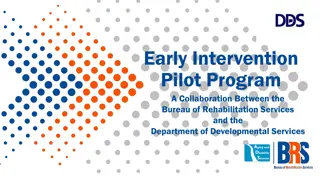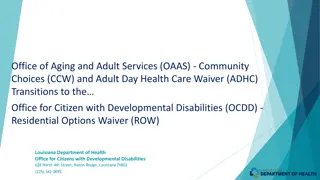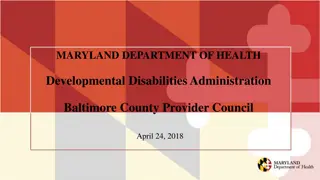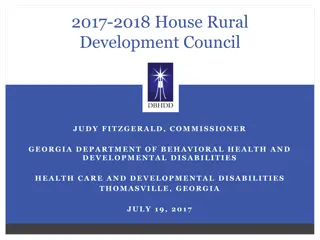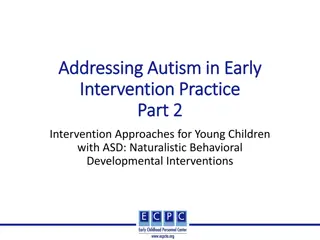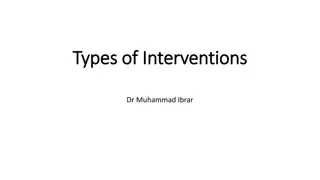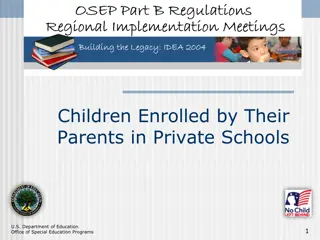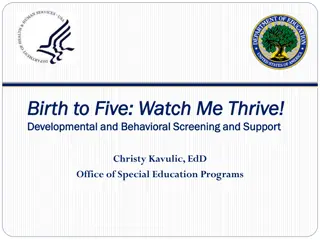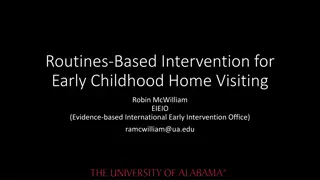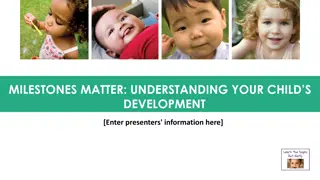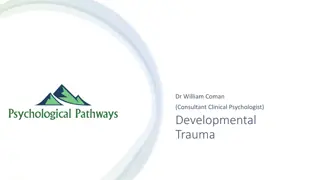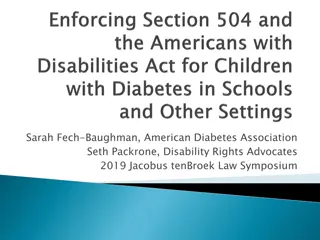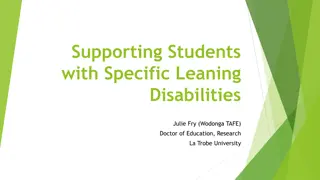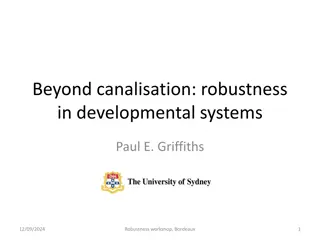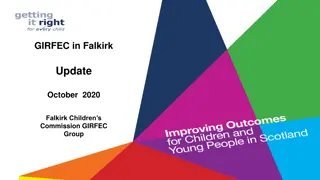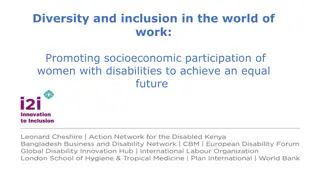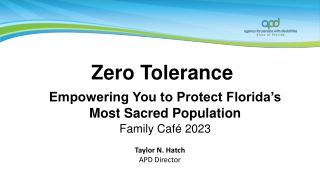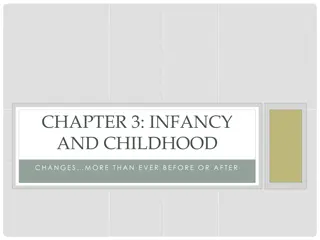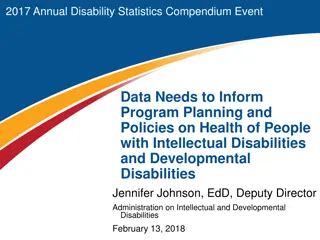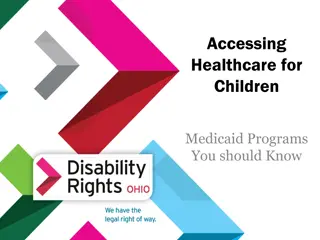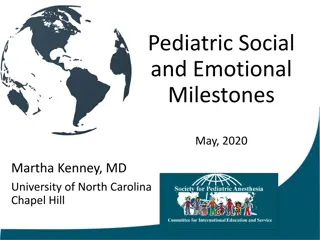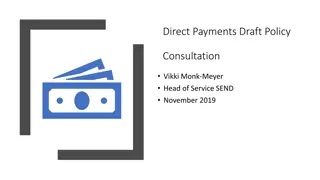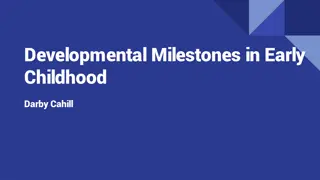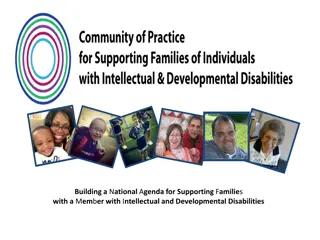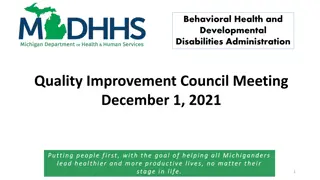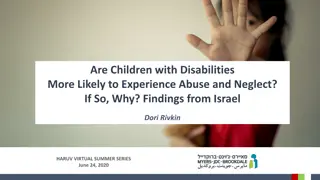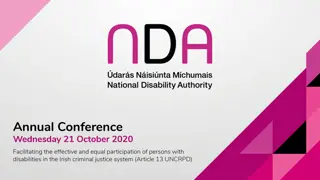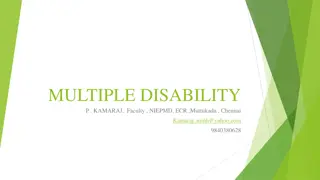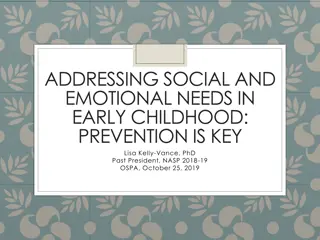Importance of Early Intervention in Children with Developmental Disabilities
Investing in early intervention for children with intellectual developmental disabilities can lead to significant long-term benefits, including improved cognitive and emotional outcomes, reduced public expenditure, and better social integration. Research shows that high-quality programs for disadvantaged children yield a substantial return on investment and contribute to positive health and economic outcomes. Late intervention can result in increased costs and missed opportunities for prevention. Addressing delays in childhood through targeted interventions can positively impact development, family engagement, and advocacy efforts.
Download Presentation

Please find below an Image/Link to download the presentation.
The content on the website is provided AS IS for your information and personal use only. It may not be sold, licensed, or shared on other websites without obtaining consent from the author. Download presentation by click this link. If you encounter any issues during the download, it is possible that the publisher has removed the file from their server.
E N D
Presentation Transcript
Early intervention in children with intellectual developmental disabilities: a trial of stepping stones triple P in the UK Prof Angela Hassiotis UCL Division of Psychiatry & Camden Learning Disability Service WPA 2017 Berlin
The impact of late intervention: services and supports needed for a child in difficulty that could have been prevented Local authorities spend per person: 298 (164-531) Level of spend is associated with deprivation ( urban rural) 17bn pa in England and Wales
Why early intervention? To overcome the cognitive, emotional and resource limitations of disadvantaged children Associated with less public expenditure later in life due to better outcomes https://www.rand.org/labor.html
Investing in children Heckman and Masterov Nurse-family partnership Quality early childhood development heavily influences health, economic and social outcomes for individuals and society at large High-quality birth-to-five programs for disadvantaged children can deliver a 13% per year return on investment a rate substantially higher than the 7-10% return previously established for preschool programs serving 3- to 4-year-olds. Significant gains are realized through better outcomes in education, health, social behaviors, and employment Nobel Memoria Prize in Economic Sciences https://heckmanequation.org/resou rce/research-summary-lifecycle- benefits-influential-early-childhood- program/
Economic impacts Usually based on estimates of future employment, earnings, crime, education behavioural problems in childhood Links between conduct disorder aged 10 and 16 and later educational under-achievement and unemployment (BCS70)
http://www.eif.org.uk/ 50+ programmes Evidence and costs Lifespan early intervention (prevention)
EI 1: The child with delays and its family (Guralnick 2017) Benefits child development, engaging with professionals and advocacy for the child Developmental science (syndrome specific/neuroscience/genetics) Parent responsiveness and patterns of interaction Parent resources, e.g. stress Schooling and peer competencies Challenges child social and cognitive competence, family patterns of interaction, and family resources effect size 0.50 to 0.75 SDs
Mental health problems in children with ID Rutter et al: 30% vs 7% (Isle of Wight studies) Emerson & Hatton: 39% vs 8% (ONS http://www.lancaster.ac.uk/staff/emersone/FASSWeb/Emerson_07_FP LD_MentalHealth.pdf) Longitudinal follow-up shows that challenging behaviours persist over time but only 10% of participants receive any intervention (Einfeld et al, 2007) Lower use of services but level of morbidity
Factors predicting mental illhealth/challenging behaviour in children with ID lone parent family, income poverty; exposure to 2 or more negative life events; poor family functioning; primary carer with no educational qualifications; maternal mental health issues; poor maternal self- rating of health Emerson and Hatton (2008): cumulative risk of exposure to indicators of social disadvantage are associated with increased prevalence of emotional disorders, conduct disorders and hyperactivity in children.
http://www.challengingbehaviour.org.uk/learning- disability-files/Briefing-Paper.pdf
EI 2: the child with delays and challenging behaviour Early intervention can be helpful and cost effective in supporting families with children who present with challenging or antisocial behaviours. Parent groups
How do the parenting programmes work? Focused short-term intervention to address parenting limitations Use social learning Various underpinning theories e.g. Behavioural to encourage/discourage behaviour; systemic approaches; attachment based Parents value the support in a group setting
https://www.scie.org.uk/publications/ataglanc e/ataglance11.asp
EPICC-ID Overview Comparator Health visitor services; Primary care engagement and advice; Version of early intervention provided by a variety of services; Parenting advice and support sessions by carer groups/third sector organisations. Parents will receive a list of national and local resources and the Contact a Family guide to challenging behavior Participants Parents aged =>18 years of age Child 30 to 59 months old at identification with moderate to severe ID Parent report of challenging behaviour maintained no less than 2 months Intervention Level 4 SSTP, a 9 week programme providing a combination of group and individual support to help parents develop skills to manage their child s behaviour effectively Outcome(s) Parent reported severity of challenging behaviour measured by preschool Child Behaviour Check List) at 12 months post randomisation
SSTP requirements http://www.triplep.net/files/8214/3139/5749/Triple_P_Practitio ner_Info_Sheet_Grp_Stepping_Stones_UK_2014.pdf 2x therapists per site 4 days of training (split in 3 days and a half day 6 weeks later for accreditation)-scheduled for June 2017 Triple P UK offers a community of practice and other peer supports and tutorials to enhance skills and delivery 2 hr groups of 5-7 parents will be run by 2 therapists x 5 weeks followed x 3 individual telephone contacts with each parent and a final session Supervision and support by TP trainers Sessions to be videotaped for fidelity assessment Therapists will complete study related paperwork and sessions checklists to aid fidelity assessment
Hypotheses Primary: adding level 4 SSTP to TAU will reduce challenging behaviour at 12 months post randomisation measured with the parent completed preschool Child Behaviour Checklist (CBCL). Secondary: adding level 4 SSTP to TAU will: 1. reduce challenging behaviour measured at 12 months post randomisation on caregiver completed CBCL (C-TRF) 2. reduce blind rated observed challenging behaviour in the child at 12 months post randomisation on Revised Family Observation Scales 3. be cost-effective
Eligibility INCLUSION Parent >18 years; child aged 30-59 months at identification; moderate to severe ID (ABAS General Adaptive Functioning); written informed consent by parent/caregiver; reports of challenging behaviour 2 months/longer EXCLUSION Child has mild, profound or no ID on parent reported ABAS; parent/carer has insufficient English language to complete study questionnaires; another sibling is taking part in the study
Sample size and other aspects 258 children are required to detect a low to moderate (standardised) effect size of 0.40 for the primary outcome CBCL at 12 months at the 5% significance level with 90% power Internal pilot x 10 m Treatment fidelity Process evaluation
Parents of 30-59 month intellectual disabilities (ID) either referred for or concerned with the child s behaviour. Recruited from clinical service pathways, parent organisations, clinical and research networks Lead-in Recruitment of study personnel and practitioners and training in SSTP* Parent agrees to meet the RA** and child is screened for level of ID (ABAS***) 2 weeks If challenging behaviour persists and the parents consent to take part, baseline assessment is undertaken and then randomised to trial n=258 (including internal pilot=7 months) If behaviour improves, no further action Measures at baseline, 4 and 12 months Primary: Preschool Child Behaviour Checklist (CBCL)- parent Secondary: Revised Family Observation Schedule, FOS-RIII; Child Behaviour Checklist Caregiver-Teacher Report Forms; C-TRF; General Health Questionnaire, GHQ-12-parent; Questionnaire on Resources and Stress, QRS-F-parent; Caregiving Problem Checklist-Difficult Child Behaviour-parent; Parenting Sense of Competence Scale, PSOC-parent; Paediatric Quality of Life, PedsQLparent; study specific Child and Adolescent Service Use Schedule, CA-SUS- parent/records; EQ-5D parent. Other Case Report Form; Bayley Scales of Infant and Toddler Development 3rd Edition (child- baseline); Client Satisfaction Questionnaire (parent-4 months); TAU**** n=103 Group SSTP n=155 Number of drop outs recorded 4 months f/u Post treatment 4 months f/u Post treatment Number of drop outs recorded 12 months f/u Child 42-71 months 12 months f/u Child 42-71 months *: group Stepping Stones Triple P **: Research Assistant ***: Adaptive Behaviour Assessment System ****: Treatment as usual
Health economics Parent resource utilisation Cost-effectiveness analysis: mean incremental cost from the health and social care perspective per change in CBCL Cost-benefit analysis of impact of child s behaviour on the parents
Other aspects 4 areas (N & S London, NE & NW England) 8 participants recruited and randomised so far
Effectiveness of Parent Mediated Intervention for Challenging Behaviour in Pre-school Children with ID CI Angela Hassiotis Coapplicants (alphabetical order) Contact Una Summerson Trial Manager Michaela Poppe Research assistants Vickie Ratti and Holly Walsh Michael Absoud, Jacqueline Barnes, Marinos Kyriakopoulos, Kate Oulton, Eleni Paliokosta, Aditya Sharma, Vicky Slonims, Alistair Sutcliffe, Megan Thomas Collaborator Jeremy Turk Priment CTU Gareth Ambler, Rachael Hunter, Monica Panca
Thank you @likahassiotis @EPICC_ID a.hassiotis@ucl.ac.uk





